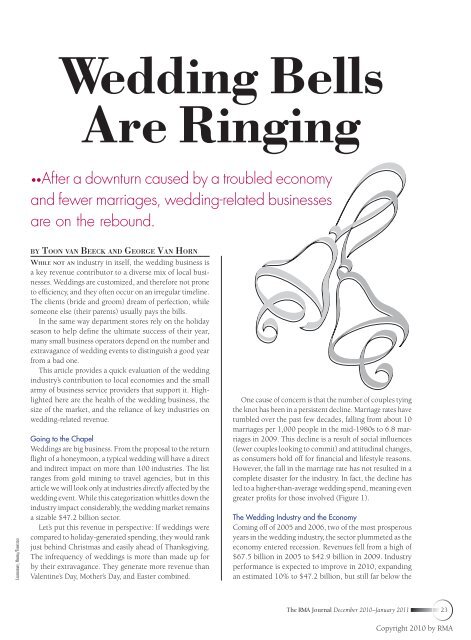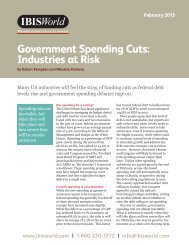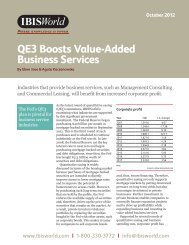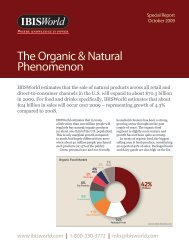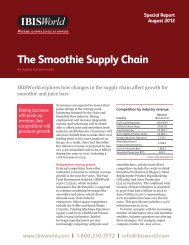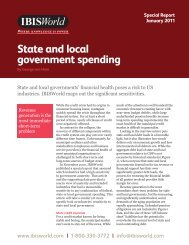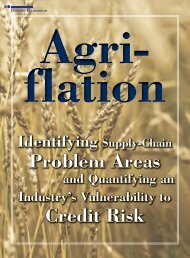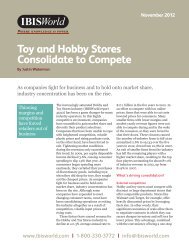Wedding Industry - IBISWorld
Wedding Industry - IBISWorld
Wedding Industry - IBISWorld
Create successful ePaper yourself
Turn your PDF publications into a flip-book with our unique Google optimized e-Paper software.
<strong>Wedding</strong> Bells<br />
Are Ringing<br />
••After a downturn caused by a troubled economy<br />
and fewer marriages, wedding-related businesses<br />
are on the rebound.<br />
Liquidlibrary, Hemera/Thinkstock<br />
b y To o n va n Be e c k a n d Ge o r g e Va n Ho r n<br />
Wh i l e n o t a n industry in itself, the wedding business is<br />
a key revenue contributor to a diverse mix of local businesses.<br />
<strong>Wedding</strong>s are customized, and therefore not prone<br />
to efficiency, and they often occur on an irregular timeline.<br />
The clients (bride and groom) dream of perfection, while<br />
someone else (their parents) usually pays the bills.<br />
In the same way department stores rely on the holiday<br />
season to help define the ultimate success of their year,<br />
many small business operators depend on the number and<br />
extravagance of wedding events to distinguish a good year<br />
from a bad one.<br />
This article provides a quick evaluation of the wedding<br />
industry’s contribution to local economies and the small<br />
army of business service providers that support it. Highlighted<br />
here are the health of the wedding business, the<br />
size of the market, and the reliance of key industries on<br />
wedding-related revenue.<br />
Going to the Chapel<br />
<strong>Wedding</strong>s are big business. From the proposal to the return<br />
flight of a honeymoon, a typical wedding will have a direct<br />
and indirect impact on more than 100 industries. The list<br />
ranges from gold mining to travel agencies, but in this<br />
article we will look only at industries directly affected by the<br />
wedding event. While this categorization whittles down the<br />
industry impact considerably, the wedding market remains<br />
a sizable $47.2 billion sector.<br />
Let’s put this revenue in perspective: If weddings were<br />
compared to holiday-generated spending, they would rank<br />
just behind Christmas and easily ahead of Thanksgiving.<br />
The infrequency of weddings is more than made up for<br />
by their extravagance. They generate more revenue than<br />
Valentine’s Day, Mother’s Day, and Easter combined.<br />
One cause of concern is that the number of couples tying<br />
the knot has been in a persistent decline. Marriage rates have<br />
tumbled over the past few decades, falling from about 10<br />
marriages per 1,000 people in the mid-1980s to 6.8 marriages<br />
in 2009. This decline is a result of social influences<br />
(fewer couples looking to commit) and attitudinal changes,<br />
as consumers hold off for financial and lifestyle reasons.<br />
However, the fall in the marriage rate has not resulted in a<br />
complete disaster for the industry. In fact, the decline has<br />
led to a higher-than-average wedding spend, meaning even<br />
greater profits for those involved (Figure 1).<br />
The <strong>Wedding</strong> <strong>Industry</strong> and the Economy<br />
Coming off of 2005 and 2006, two of the most prosperous<br />
years in the wedding industry, the sector plummeted as the<br />
economy entered recession. Revenues fell from a high of<br />
$67.5 billion in 2005 to $42.9 billion in 2009. <strong>Industry</strong><br />
performance is expected to improve in 2010, expanding<br />
an estimated 10% to $47.2 billion, but still far below the<br />
The RMA Journal December 2010–January 2011 23<br />
Copyright 2010 by RMA


